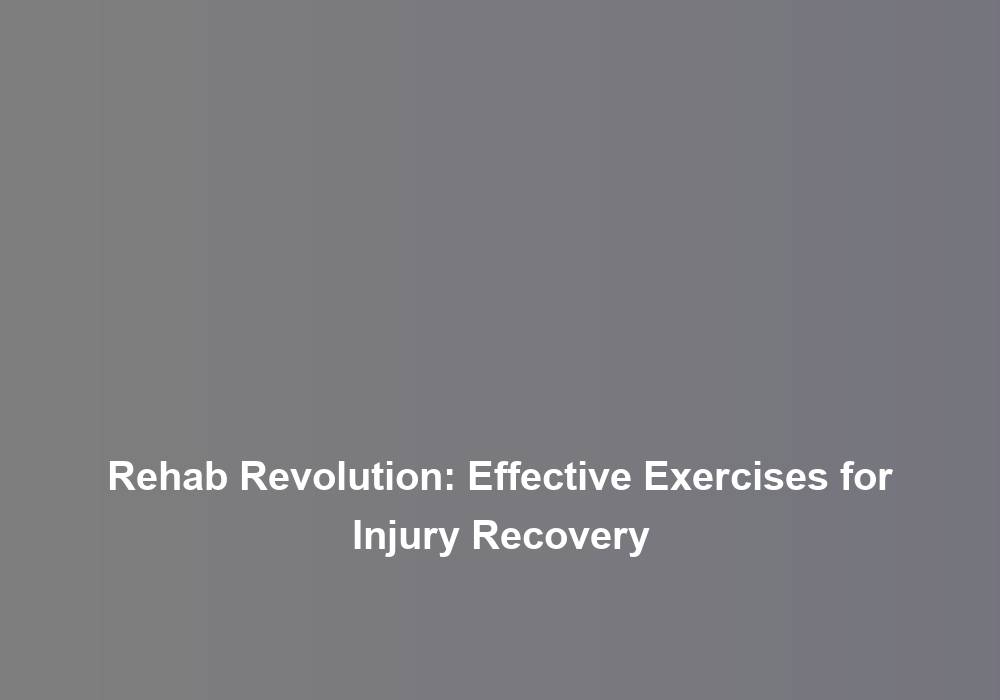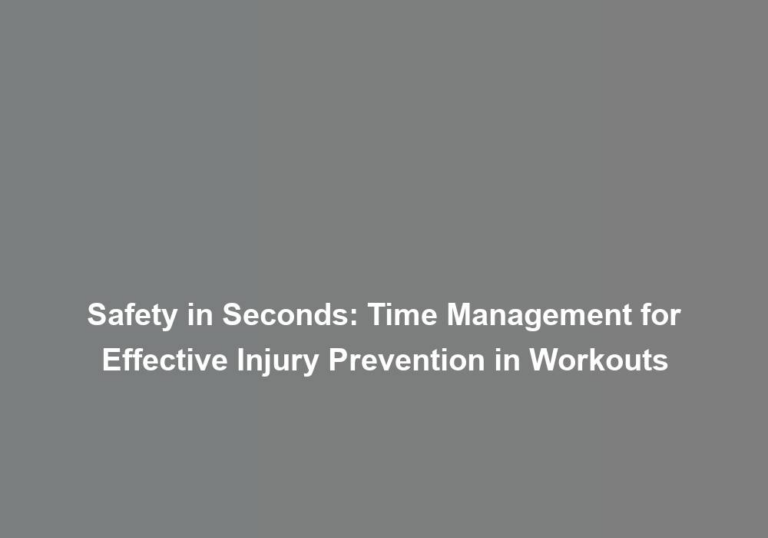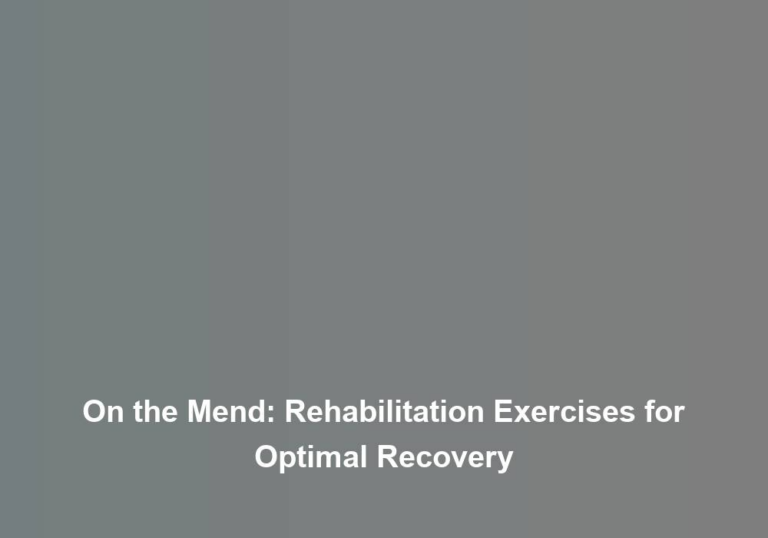Rehab Revolution: Effective Exercises for Injury Recovery
When youG??re recovering from an injury, it often feels like youG??re navigating through a maze of uncertainty and setbacks. However, imagine if there was a roadmap to guide you towards a smoother and more effective rehabilitation journey. The key to successful injury recovery lies in the revolutionary approach of targeted exercises that not only heal, but also strengthen and protect your body. These exercises are designed to not only restore physical function but also prevent future injuries. So, how can you harness the power of these exercises to reclaim your strength and mobility?
Stretching for Flexibility and Mobility
To improve your flexibility and mobility during injury recovery, incorporating regular stretching exercises into your routine is essential. Dynamic stretches are an excellent way to enhance your flexibility while also preventing future injuries. These stretches involve continuous movement, such as leg swings or arm circles, which help to improve blood flow and warm up your muscles before engaging in more intense physical activity. By incorporating dynamic stretches into your daily routine, you can gradually increase your range of motion and reduce the risk of further injury.
Active stretching is another crucial component for post-workout recovery during injury rehabilitation. This type of stretching involves holding a stretch position with the assistance of an external force, like a partner or a stretching band. Active stretching helps to maintain and improve your flexibility, which is especially important during recovery when muscles may be prone to tightening and shortening due to inactivity. By incorporating active stretching into your routine, you can promote better circulation, reduce muscle stiffness, and improve your overall mobility.
Low-Impact Cardio for Endurance
When recovering from an injury, itG??s important to gradually build up your endurance. Low-impact cardio exercises are a great option for improving stamina without putting too much strain on your body. Incorporating gentle cardio into your routine can help you safely increase your endurance and aid in your recovery process.
Gentle Cardio Options
Consider incorporating low-impact cardio exercises into your routine to build endurance and aid in your injury recovery. Here are some gentle cardio options to help you stay active and promote healing:
- Low impact walking or cycling: These activities are easy on your joints while still providing a good cardiovascular workout.
- Water aerobics: Exercising in water reduces impact on your body, making it a great option for injury recovery.
- Gentle swimming: Swimming is a full-body workout that is gentle on your muscles and joints, perfect for building endurance without risking further injury.
- Elliptical training: Using an elliptical machine provides a low-impact way to improve your cardiovascular fitness while minimizing stress on your joints.
Incorporating these low-impact cardio exercises can help you stay active and maintain your endurance while allowing your body to recover from injury.
Building Stamina Safely
Incorporating low-impact cardio exercises into your routine can effectively aid in your injury recovery while also helping you build stamina safely and improve endurance. Safe progression is key to preventing further injury and gradually increasing your cardiovascular endurance. Start with activities like swimming, stationary cycling, or using an elliptical machine to minimize impact on your joints while still challenging your cardiovascular system. Aim for 20-30 minutes of low-impact cardio, gradually increasing the duration as your stamina improves. Listen to your body and avoid pushing yourself too hard too soon. Remember, the goal is to build endurance over time, so be patient with your progress. By gradually increasing the intensity and duration of your low-impact cardio sessions, you can safely improve your stamina and prevent future injuries.
Resistance Training for Strength
To build strength and aid in your injury recovery, incorporate resistance training exercises into your routine, focusing on compound movements for maximum effectiveness. Resistance training is crucial in your recovery progress as it not only helps in injury prevention but also improves your overall strength and stability. Here are some effective resistance training exercises to incorporate into your routine:
-
Squats: This compound movement targets multiple muscle groups, including the quadriceps, hamstrings, and glutes. Start with bodyweight squats and gradually progress to using resistance such as dumbbells or barbells.
-
Deadlifts: Deadlifts are excellent for strengthening the posterior chain, including the lower back, glutes, and hamstrings. Ensure proper form and start with lighter weights before increasing the load.
-
Push-Ups: A classic exercise that targets the chest, shoulders, and triceps. Begin with modified push-ups if needed and gradually progress to standard push-ups as your strength improves.
-
Rows: Incorporate rowing exercises to strengthen the upper back and biceps. You can perform bent-over dumbbell rows or use resistance bands for a challenging yet effective workout.
Incorporating these resistance training exercises into your routine will not only aid in your injury recovery but also contribute to your overall strength and stability. Remember to start with lighter weights and gradually increase the resistance as your strength progresses. Always consult with a healthcare professional before starting any new exercise regimen to ensure it aligns with your recovery plan.
Balance and Stability Exercises
YouG??re now ready to focus on improving your balance and stability. These exercises will help strengthen your core and improve your proprioception, which is your bodyG??s ability to sense its position and movement. By incorporating these exercises into your routine, youG??ll be on your way to regaining your strength and stability post-injury.
Core Strengthening
Strengthen your core with these balance and stability exercises to aid in your injury recovery. Building core stability is crucial for injury prevention and overall recovery. Here are some effective exercises to help you achieve this:
- Plank: Start with holding a plank position for 30 seconds and gradually increase the duration as you build strength.
- Russian Twists: Sit on the floor, lean back slightly, and rotate your torso from side to side while holding a weight or medicine ball.
- Single-Leg Balance: Stand on one leg, keeping your core engaged and maintaining your balance for 30 seconds, then switch to the other leg.
- Bird Dog: Get on your hands and knees, and extend one arm and the opposite leg simultaneously while keeping your core stable.
Incorporating these exercises into your routine will not only aid in your recovery but also improve your overall balance and stability.
Proprioception Training
Improving your proprioception through balance and stability exercises is essential for enhancing your injury recovery and preventing future setbacks. By incorporating balance improvement and injury prevention exercises into your routine, you can retrain your body to better sense its position, movements, and external forces. Start with simple exercises like single-leg stands, balance board activities, or stability ball workouts. These exercises challenge your body to maintain stability, which can help prevent re-injury by improving your ability to react to sudden movements or uneven surfaces. Gradually progress to more dynamic movements such as lunges, squats, and single-leg hops to further enhance your balance and stability. Consistent practice of these exercises will not only aid in your injury recovery but also build a strong foundation for preventing future injuries.
Neuromuscular Re-Education Techniques
Using targeted exercises and specific movement patterns, neuromuscular re-education techniques aim to retrain the brain and muscles to work together effectively during injury recovery. These techniques are crucial for restoring motor control and improving movement retraining after an injury. Here are some key components to consider when incorporating neuromuscular re-education into your rehabilitation routine:
-
Focus on Mind-Body Connection: Engage in exercises that require concentration and mindfulness, such as balancing on one leg or performing controlled movements. This helps re-establish the connection between your brain and muscles, enhancing coordination and control.
-
Utilize Proprioceptive Feedback: Incorporate activities that challenge your bodyG??s awareness of its position in space, like using balance pads or unstable surfaces. This aids in sharpening proprioception, which is essential for regaining stability and preventing re-injury.
-
Progressive Resistance Training: Gradually increase the resistance in your exercises to stimulate muscle strength and endurance. This progressive approach helps rebuild muscle function while promoting neuromuscular adaptation.
-
Functional Movement Integration: Integrate movements that mimic everyday activities, such as squatting, lifting, or stepping. By practicing these functional movements, you can enhance the transfer of neuromuscular improvements to real-life situations, promoting a smoother transition back to normal activities.
Incorporating these techniques into your rehabilitation program will not only aid in your recovery but also empower you to regain confidence in your bodyG??s capabilities. Remember, consistency and patience are key as you work towards rebuilding your strength and coordination.
Functional Movement Patterns for Daily Activities
To enhance your recovery and prepare for a smooth return to your daily activities, itG??s essential to focus on incorporating functional movement patterns into your rehabilitation routine. Understanding and practicing these movements will not only aid in your rehabilitation progress but also ensure that you can effectively perform daily activities with reduced risk of re-injury. Functional movement assessment is a crucial element in identifying specific movement deficiencies and asymmetries that may have contributed to your injury. By targeting these areas, you can improve your overall movement patterns and enhance your ability to perform activities of daily living.
HereG??s a simple table outlining some common functional movement patterns and their relevance to daily activities:
| Functional Movement Pattern | Relevance to Daily Activity |
|---|---|
| Squatting | Sitting and standing up |
| Lifting | Carrying groceries |
| Walking | Moving around |
| Reaching | Putting items on shelves |
Incorporating exercises that mimic these functional movement patterns into your rehabilitation routine can significantly contribute to your overall recovery and readiness to engage in your daily activities. Your body is designed to move in a coordinated and efficient manner, and by focusing on these functional movements, you can improve your movement quality, reduce the risk of future injuries, and regain confidence in performing daily tasks.
Conclusion
As you continue on your journey of injury recovery, think of it as a beautiful garden. Each exercise is like a different flower, adding color and vitality to your body. Stretching and mobility work like the sun, bringing flexibility and warmth. Low-impact cardio is the gentle rain, nourishing your endurance. Resistance training is the strong roots, grounding you with strength. Balance, stability, and neuromuscular exercises are like the gentle breeze, helping you sway and move with ease. And functional movement patterns are the pathway, guiding you through your daily activities with grace and ease. Keep tending to your garden, and watch it bloom with strength and resilience.







